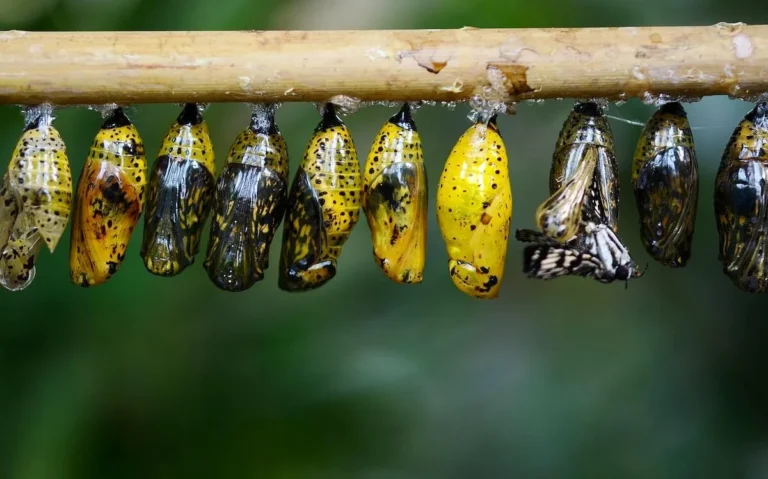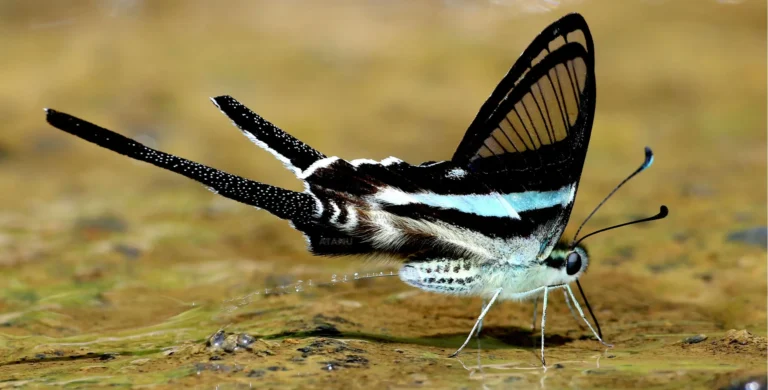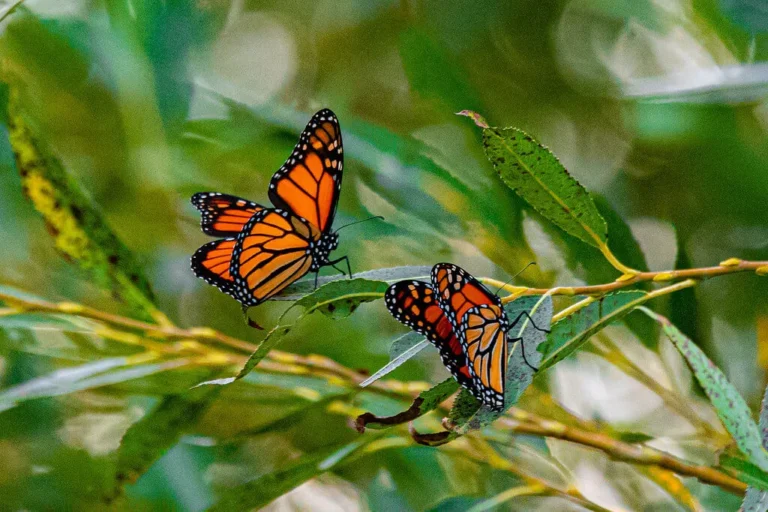Plain Tiger Butterfly (Danaus chrysippus): A Detailed Guide
Quick Summary: The Plain Tiger Butterfly, scientifically known as Danaus chrysippus, is a vibrant butterfly known for its bright orange wings adorned with black and white patterns. Common in Asia, Africa, and parts of Australia, it thrives in grasslands and moist forests. Its life cycle includes stages of egg, larva, pupa, and adult, with each stage presenting unique characteristics. The butterfly, a symbol of transformation and renewal, has a significant cultural and symbolic presence in art and literature.
Table of Contents
Introduction
Overview of Danaus chrysippus
In the vibrant world of butterflies, the Plain Tiger Butterfly, scientifically known as Danaus chrysippus, stands out with its bright colors and unique patterns.
This butterfly is not just a beauty to behold but also plays a significant role in the biological community.
Often found fluttering in gardens and wildflowers, these butterflies bring a touch of grace wherever they go.
Importance in the Biological Community
The Plain Tiger Butterfly is not just known for its beauty, but also for its vital role in the ecosystem. Being a pollinator, it helps in the process of plant reproduction, assisting in the creation of fruits and seeds that many creatures rely on for food.
Furthermore, they serve as a food source for various predators, maintaining a balanced and healthy environment.
Taxonomy and Classification
When we talk about the classification of the Plain Tiger Butterfly, it falls under the following categories:
- Kingdom: Animalia, meaning it is an animal.
- Phylum: Arthropoda, which signifies that it is an invertebrate with an exoskeleton, a segmented body, and jointed limbs.
- Class: Insecta, indicating it belongs to the insect class.
- Order: Lepidoptera, the group that consists of butterflies and moths.
- Family: Nymphalidae, a family that encompasses many well-known butterflies.
- Genus: Danaus, a category housing bright, medium-sized butterflies.
- Species: Chrysippus, referring specifically to the Plain Tiger Butterfly.
Brief Discussion on Plain Tiger Butterfly and its Distinguishing Features
The Genus Danaus is remarkable because it is home to some of the most striking butterflies that you will come across.
Members of this genus are often characterized by their vibrant orange wings marked with black lines and white spots, giving them a distinctive and charismatic appearance.
What makes them even more fascinating is their remarkable migratory behavior, where they travel long distances in groups, a sight that is simply a joy to witness.
Morphological Characteristics
Detailed Description of Physical Attributes
The Plain Tiger Butterfly is a visual delight with its striking physical attributes. When you spot one, the first thing you notice is its vibrant color palette.
Its wings are primarily bright orange, which glistens under the sun, creating a beautiful display of nature’s artistry.
Wing Patterns and Color Variations
One of the remarkable Plain Tiger Butterfly characteristics is the intricate patterns on its wings. It has black markings and a series of white spots that grace the edges of its wings, creating a beautiful contrast against the orange backdrop. These patterns are not just for show; they help in camouflaging and protecting the butterfly from predators.
Body Structure: Head, Thorax, and Abdomen
Looking beyond its wings, the body of Danaus chrysippus is segmented into three main parts: the head, thorax, and abdomen. The head houses the antennae and compound eyes, which aid in navigation and finding food sources.
The thorax is the powerhouse, hosting the muscles that control the wings and legs, facilitating movement. Lastly, the abdomen contains vital organs necessary for digestion and reproduction.
Comparison with Similar Species
The Plain Tiger Butterfly shares its bright orange hues with some other butterflies like the Monarch and Painted Lady. However, it stands out due to its smaller size and distinctive wing patterns that flaunt more white spots and complex black markings.
This makes it a unique species in the butterfly world, holding its own amidst a vibrant community of fluttering beauties.
Plain Tiger Butterfly Life Cycle and Development
Eggs: Description and Where They Are Commonly Laid
The life journey of the Plain Tiger Butterfly begins as a tiny egg. The eggs are small, round, and have a pale color, often laid singly on the leaves of milkweeds and other host plants.
This careful selection of plants ensures that the larvae will have an ample supply of food as soon as they hatch.
Larva: Physical Characteristics and Feeding Habits
Once the eggs hatch, out comes the larva or caterpillar, which is a voracious eater. The caterpillar is predominantly striped in yellow and black, with small, hair-like structures giving it a slightly fuzzy appearance.
Its main job at this stage is to eat and grow, munching away on the leaves of the host plant, and storing energy for the transformation it will soon undergo.
You might also wanna learn about what Luna moths eat.
Pupa: Transformation Process
As the caterpillar reaches its growth limit, it transitions into the pupa stage, a period of intense transformation. In this phase, the caterpillar finds a safe spot to attach itself and forms a protective casing called a chrysalis.
Inside this protective shell, it undergoes remarkable changes, rearranging its body cells to form a budding butterfly. This process is nature’s magnificent way of creating new life forms.
Adult: Morphological Features and Lifespan
After a few weeks in the chrysalis, the adult Plain Tiger Butterfly emerges, flaunting new wings and vibrant colors. The adult butterfly is a sight to behold with its bright orange wings adorned with black and white patterns.
It now starts on a new journey, fluttering around gardens and meadows, sipping nectar from flowers, and participating in the cycle of reproduction to ensure the survival of its species.
The lifespan of an adult butterfly can range from a few weeks to several months pretty similar to a monarch butterfly’s lifespan, during which it graces the world with its beauty and contributes to the balance of nature.
Habitat and Geographical Distribution
Specific Habitats Where They Thrive
The Plain Tiger Butterfly is quite adaptable and can be found in various environments ranging from dry grasslands to moist forests.
They have a particular fondness for flowery meadows, gardens, and places where host plants are abundant.
These butterflies favor warm climates and are often seen basking in the sun, soaking up their energy to flutter around with grace and vibrancy.
Geographic Regions Where They are Commonly Found
Geographically, the range of the Plain Tiger Butterfly is vast. They are predominantly found in Asia, Africa, and parts of Australia.
In these regions, they grace various landscapes with their presence, from the tropical forests of Southeast Asia to the savannas of Africa.
Their wide distribution is a testimony to their adaptability and resilience, making them a common sight in many parts of the world.
Behavior and Ecology
Feeding Habits and Common Food Sources
The adult Plain Tiger Butterfly has a diet mainly consisting of nectar from flowers. They have a specialized mouthpart called a proboscis, which acts like a straw to help them sip the sweet nectar from flowers.
This nectar not only provides them with energy but also helps in pollination, as they carry pollen from one flower to another.
Apart from nectar, they also occasionally feed on ripe fruits, deriving necessary nutrients to keep them vibrant and healthy.
Predatory Defense Mechanisms
One of the most fascinating Plain Tiger Butterfly facts is its defense mechanism against predators. Their bright colors are not just for beauty but also serve as a warning sign to predators. The larvae feed on milkweed, which contains toxic substances making them somewhat poisonous to predators.
These substances are stored in their body and retained even in their adult form, making them unpalatable to predators. This is a smart strategy that helps in their survival in the wild.
Mating and Reproductive Behaviors
When it comes to mating, the Plain Tiger Butterfly exhibits interesting behaviors. The males are known to be territorial, often choosing prominent spots to watch over their territory and to attract a mate.
Once they find a suitable mate, the courtship begins, involving gentle fluttering and tactile signals. After mating, the females go on a quest to find the perfect host plants to lay their eggs, ensuring the next generation has a great start in life.
In this segment, we got a glimpse into the daily life and survival strategies of the Danaus chrysippus. Their feeding habits, defense mechanisms, and reproductive behaviors reflect a rich and complex life that is both fascinating and inspiring.
Cultural and Symbolic Significance
Appearances in Art and Literature
Throughout history, the captivating beauty of the Plain Tiger Butterfly has found a place in various forms of art and literature.
Artists have often been inspired by their vibrant colors and graceful flight, capturing their essence in paintings and sculptures.
In literature, they are frequently symbolized as messengers of joy and transformation, gracing the pages of poems and stories with their delicate presence.
Symbolism in Various Cultures
In various cultures, butterflies, including the Plain Tiger, are seen as symbols of transformation and renewal.
Their metamorphosis from a caterpillar to a butterfly is often paralleled by spiritual transformation and personal growth.
In some cultures, they are even seen as messengers between the living and the spiritual world, embodying grace, lightness, and the ephemeral nature of life.
Interesting Facts
Unique Characteristics
One of the unique characteristics of the Plain Tiger Butterfly is its migratory behavior. In certain seasons, they undertake long migratory journeys, traveling great distances in groups.
This mass movement is a breathtaking sight and a wonderful spectacle of nature. Additionally, their ability to play dead as a form of defense against predators is a fascinating survival tactic, which can be observed in other species as well, such as the luna moth.
Notable Sightings and Historical References
Historically, the Plain Tiger Butterfly has been a subject of interest and study for many naturalists and butterfly enthusiasts.
Their widespread distribution has led to notable sightings in various parts of the world, documented in many butterfly field guides and natural history books.
Their presence in human history as symbols of beauty and transformation is a testament to their lasting impact on our culture and imagination.
Conclusion
Recap of the Significance of Danaus chrysippus
As we come to the end of our journey, we reflect on the incredible world of the Danaus Chrysippus.
From their vibrant colors and intricate wing patterns to their fascinating life cycle and widespread habitats, the Plain Tiger Butterfly stands as a symbol of beauty, transformation, and the wondrous complexity of nature.
Encouraging Readers to Observe Responsibly
While enjoying the beauty of these butterflies, it is vital for us to observe them responsibly. When watching them in their natural habitats, it is important to not disturb them or their surroundings.
Let’s appreciate their beauty from a distance, ensuring that they continue to grace our world with their presence for generations to come.
We hope this journey through the world of the Plain Tiger Butterfly has been enlightening and inspiring. Remember, the next time you see a fluttering butterfly, there’s a whole world of wonder and beauty encapsulated in those delicate wings.




